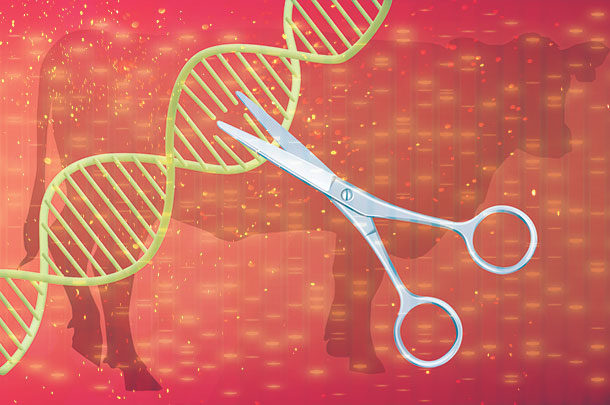It is an especially powerful tool to rapidly develop traits, such as disease and heat resistance, that are not highly heritable or even present in certain breeds. How is this possible? By mechanically acting on a specific spot on a genome, it is possible to impact and change the genotype or phenotype.
“Around the world, gene editing can have a huge impact on the day-to-day cattle operations of producers all over the world,” explains Dr. Charles Long of Texas A&M University. “We really have the ability to make very precise, specific edits to the genome that are pertinent to cattle and can significantly improve production efficiencies.”
How it works
Gene editing involves using what can be considered “molecular scissors” to make a double break at a designated spot on a genome to make a change. Instead of the cell repairing the break itself, an instruction template is provided to direct the outcome, such as introducing the polled allele by “turning off” the horned gene, which has been done successfully in dairy cattle.
Certain diseases, such as BRD, are a bit more difficult to tackle, explains Dr. Alison Van Eenennaam, a specialist in animal biotechnology and genomics at the University of California – Davis.
“BRD is a really multigenic, multifactorial, multieverything – so it’s not one of the easier ones to address with gene editing. This is because gene editing is meant to do single genes rather than multiple ones. In other words, there is not a BRD gene, so to speak,” she says. “There are other cases where you can turn off the gene, make an animal resistant to a certain disease, viruses particularly; PRRS in pigs is one example. You can turn off one gene and make pigs less susceptible to that.”
Even in tricky cases like this, there is some hope in the future as the technology and innovations progress. Van Eenennaam notes that a researcher at Washington State University has found an edit he believes will make the leukotocin that comes from Mannheimia haemolytica (the principal bacterium isolated from BRD) less damaging to the lungs, making cattle less susceptible.
There are a lot of other welfare traits especially of interest for researchers and other industry professionals. These include heat tolerance by introducing the slick gene for resistance, the polled phenotype and calving ease. Production traits are another area in which this technology could advance cattle efficiency by leaps and bounds.
“One thing we’ve been working on projects to improve meat quality in the Bos indicus breeds,” says Long. “Be it milk production, beef production, animal welfare; you can name off pretty much any trait you might want to improve, and gene editing likely has an opportunity to improve those.”
Dr. Matt Spangler, beef genetics specialist at the University of Nebraska, believes cattlemen education is a part of the success to this technology.
“It is critical beef cattle producers understand what gene editing actually is and that products from gene-edited animals are completely safe for human consumption,” he says.
Another thing he notes is the importance of understanding gene editing does not and will not replace the need for traditional genetic selection and strong breeding programs.
“Such as the use of EPD and indexes given, there are multiple traits that impact profit, and the overwhelming majority of these traits are impacted by large numbers of genes,” he continues. “Gene editing is potentially a very useful tool in a large toolbox.”
Obstacles ahead?
For all its promises, gene editing still has some ways to go before it becomes a mainstream, accepted practice. Beef producers and industry professionals have expressed a lot of interest in this technology, but there are several obstacles preventing it to be status quo just yet.
One of these obstacles would be making this intricate technology accessible to breeders in a variety of different management systems.
Van Eenennaam explains, “That might be really easy in dairy cattle where you have a lot of animals sired by an A.I. bull, but it becomes more difficult in industries like beef, where you’ve got a lot of natural-service sires so it’s difficult to distribute genetics in that kind of an industry.”
The bigger issue facing gene-editing adaptation are regulations and public acceptance. Currently, gene-edited animals are not permitted to enter the U.S. food system. The proposed regulatory approach by the FDA is to consider every new gene-edited animal as if it were a drug and to treat them as such in the approval process. According to Van Eenennaam, such a stance makes it almost entirely cost-prohibitive to make the technology widely acceptable.
“That’s effectively derailed the genetic engineering in animal breeding programs, and I fear it will have the same impact on genome editing, at least in America,” she says. “Other countries, for example Brazil and Argentina, have a very different approach; they are basically looking at the product on a risk basis … we may see the technologies move to these countries more.”
In terms of public acceptance, it is easy for activist groups to target livestock technology the same way genetic engineering was protested. While this isn’t a major concern just yet, there is likely opposition ahead when the technology becomes more mainstream.
And of the benefits? In spite of the difficulties facing this science, there are many involved in the process who are pushing to keep the technology moving forward. There is a strong belief that the potential benefits are too important to not be accessed.
“If you look at a sustainability lens, we lose about 20 percent of animal production to disease,” Van Eenennaam elaborates. “If you can prevent disease, you can view it as increasing efficiency 20 percent and thereby decreasing the environmental footprint of animal agriculture, so this is good for everybody.”
Funding also isn’t easy for these projects, most of it coming from within the industry’s own companies as opposed to U.S. funding agencies.
“It’s coming from the biomedical side of things, so we can essentially make the same kind of gene-editing advancements to make biomedical models of human diseases; it’s the same technology, so we can still use livestock and use gene-editing applications without having direct funding for agriculture,” says Long.
Gene-editing technology has some hurdles yet to face before it goes mainstream. But the role it can play will be a huge part as the industry moves forward.
“Tools such as EPD, indexes and structured crossbreeding are still critical to use but certainly underutilized – there is much room for improvement,” says Spangler. “This is not opinion; it is fact.” ![]()
ILLUSTRATION: Illustration by Kristen Phillips.
Jaclyn Krymowski is a freelancer based in Ohio.









